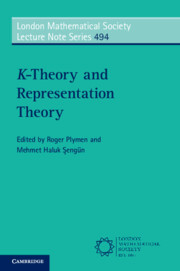1 - Group C*-Algebras, C*-Correspondences and K-Theory
Published online by Cambridge University Press: 06 November 2024
Summary
We start by introducing C*-algebras associated with locally compact groups. Next, the theory of Hilbert modules, C*-correspondences, crossed-product algebras, and Morita equivalence are discussed. This is followed with applications to Mackey’s theory of induction of representations and Howe’s theory of theta correspondence. Next, K-theory and (equivariant) KK-theory are introduced. Connections between isolated points in the unitary dual and generators of the K-theory of C*-algebras of liminal groups are discussed.
Keywords
- Type
- Chapter
- Information
- K-Theory and Representation Theory , pp. 1 - 36Publisher: Cambridge University PressPrint publication year: 2024

